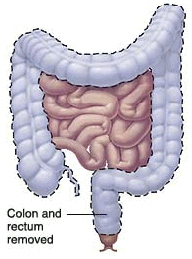Having Bowel Surgery: Ileoanal Pouch
Having Bowel Surgery: Ileoanal Pouch
This surgery is done to treat diseases of the digestive tract. It removes all of the large intestine. When healed, bowel movements still occur through the anus.
The pouch is also called a "J-pouch" for the shape of the pouch.
Preparing for surgery
Preparation may start a few weeks before surgery and can include the following:
If you smoke, get help from your healthcare provider to quit.
Tell your doctor about any medicines (including aspirin, NSAIDs, and blood thinners), herbs, or supplements you take. Ask whether you should stop any of them before surgery.
If you will have a stoma, a specially trained healthcare provider called an enterostomal therapy (ET) nurse will meet with you. The ET nurse will help you determine the optimal location for the stoma on the abdominal wall.
Follow any directions you are given for taking medicines and for not eating or drinking before surgery. This includes any instructions for bowel prep.
The procedure
The colon and rectum are removed.
The anus and surrounding muscles are left in place.
Part of the small intestine is reshaped to form a pouch within the body. The pouch works like a rectum. It stores waste until a bowel movement occurs.
A temporary ileostomy may be needed as the intestine heals. This is a procedure that lets waste pass into a pouch outside the body.
Risks and complications
Bowel surgery has certain risks and possible complications. Your healthcare provider can discuss them with you. They may include:
Infection
Injury to nearby organs
An anastomosis that leaks
Blood clots
Risks related to anesthesia
Pouch inflammation or malfunction
Diarrhea is very common after surgery. Over weeks to months, the bowel returns closer to normal. But, most people end up with more frequent and softer bowel movements than before. Sometimes a bowel movement occurs overnight. If the pouch is suspected of having a problem, a flexible tube (a scope) can be placed inside to look around and diagnose the problem.
Updated:
March 21, 2017
Sources:
Restorative Proctocolectomy with ileal pouch anal anastomosis laparoscopic approach, Up To Date
Reviewed By:
Fetterman, Anne, RN, BSN,Lehrer, Michael Stephen, MD

